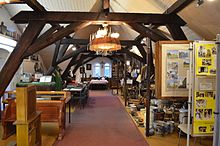Local studies (school subject)
The school subject History originally called the nahräumlich- geographically dominated educational content of elementary and primary school . In many countries History is a school-based general education through the social studies been replaced. There are also combinations, such as home and science lessons . Local studies is still a common regional technical term, for example in many cantons of Switzerland .
history
Local studies as a term for general education, especially among younger students, was widespread as early as the 19th century. Important representatives of local history were Wilhelm Harnisch (1787–1864) and Friedrich August Finger (1808–1888). At that time, local history was not yet standardized in its teaching content and was also called "object lesson". Local history was forbidden in Prussia with the Stiehl regulations in 1854 in the course of the restoration after the democratic revolution of 1848 . Local history has been mandatory in elementary schools since 1908.
Germany
Weimar Republic
Local studies became a subject recognized by guidelines for the first time in Germany in the Weimar Republic . Despite the efforts of Hugo Conwentz , for example , local history was often oriented towards rural idylls and could not offer a realistic orientation towards the problems of the present day. Only Fritz Gansberg tried at the beginning of the 20th century to open up local history as a metropolitan local history to questions of the present. However, the direction of local history influenced by Eduard Spranger prevailed , which propagated a "spiritual root feeling" and "groundedness" as the goal. However, since the beginning of the 20th century, concepts of the work school have also been represented and introduced into local history lessons from this perspective.
National Socialism
Local history was adopted almost seamlessly in its content at the time of National Socialism . At that time, only additional special festivals such as Heroes' Remembrance Day, Midsummer Day and Hitler's birthday were added to the local history topic spectrum. Otherwise, the local history course, which was conceived as a whole, remained largely the same as in the Weimar Republic.
Federal Republic

Even after the Second World War , local history was the recognized central subject of general local history teaching in primary school in the Federal Republic of Germany . It was not until the 1960s that the subject was replaced first by general knowledge and later by general instruction. The criticism of local history related to ideological overload, geographical narrowness, too little scientific knowledge and too strong orientation towards rural idyll instead of problems of the present. The term Heimatkunde was abandoned in the curriculum in 1969. However, in some federal states, combination formulas such as home and general education (HuS) remained.
GDR
In the GDR , local history was part of the lower-level curricula as a discipline of German teaching in grades 1 and 2 and as an independent subject in grades 3 and 4 until the end of 1989. In the last generations of the curriculum, it was divided into two sub-courses (introduction to social life and knowledge of nature / nature observation). In grades 3 and 4 she prepared for classes in geography, biology, physics and history in grade 5.
Switzerland
In the Swiss elementary level (CH: primary school 1st to 5th / 6th grade), Heimatkunde provides the prior knowledge of geography, history and biology, which is applied in these subjects in the upper level. Alongside language (German) and arithmetic (mathematics), it is one of the three major subjects in Swiss primary school . Other Swiss regions use other technical terms for this content area, such as “Nature - People - Mitwelt”.
Austria
In Austria, Heimatkunde was a school subject in elementary schools in all four classes until the 1970s. Above all, the students' immediate surroundings were discussed. This was very much in the tradition of geography lessons . Today this knowledge is conveyed in the learning objectives of the subject teaching , which encompasses much more. Today, however, the term is often still used in connection with local museums ("local history museum").
literature
- E. Breetz: Activation of the students in local history lessons in grades 3 and 4. In: Deutsche Lehrerzeitung, No. 10/1981, supplement.
- E. Breetz: On the map understanding in local history and geography lessons , 3rd edition, Berlin 1982.
- H. Giest & St. Wittkowske: Local history in the GDR. In: J. Kahlert et al. (Ed.), Handbuch Didaktik des Sachunterrichts, pp. 230–239. Vol. Heilbrunn 2007.
- J. Haug: Local Studies and Folklore . Tubingen 1968.
- A. Kaiser, D. Pech (Ed.): History and historical conceptions of the subject teaching . Baltmannsweiler 2004.
- Hartmut Mitzlaff: Heimatkunde and Sachunterricht - historical and systematic studies on the development of general theory - at the same time a critical development history of the homeland ideal in the German-speaking area . 3 vols. Dortmund 1985.
- Jan Palmowski: Inventing a Socialist Nation - Heimat and the Politics of Everyday Life in the GDR, 1945-1990 , Cambridge University Press, Cambridge 2009 ISBN 978-0-521-11177-5 .
- Eduard Spranger : The educational value of local history . 1923, 7th edition, Stuttgart 1967.
- Brockhaus Encyclopedia in 24 volumes, 19th edition, Volume 9, Mannheim: Brockhaus, 1989
Web links
- Dagmar Wilde: From local history to general science . Berlin 2001